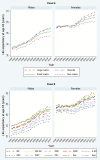Life Beyond 65: Changing Spatial Patterns of Survival at Older Ages in the United States, 2000-2016
- PMID: 31995196
- PMCID: PMC7161363
- DOI: 10.1093/geronb/gbz160
Life Beyond 65: Changing Spatial Patterns of Survival at Older Ages in the United States, 2000-2016
Abstract
Objectives: To identify levels and trends in life expectancy at age 65 (e65) by geographic region and metropolitan status in the United States.
Methods: Using county-level data on population and deaths from the Census and National Center for Health Statistics, we consider spatial inequality in e65 across 4 metropolitan types and 10 geographic regions from 2000 to 2016. We examine whether changes in e65 are driven by mortality developments in metro types or geographic regions, and compare spatial patterns in the United States to mortality trends in other Organization of Economic Cooperation and Development (OECD) countries. We use decomposition and regression methods to estimate the contributions of 10 causes of death to changes and inequalities in e65.
Results: Life expectancy at age 65 increased in all spatial units from 2000 to 2016. Areas with higher e65 in 2000 also experienced larger gains. Longevity increases were greatest in large metropolitan areas and coastal regions. Nonmetropolitan areas and the interior lagged far behind not only other parts of the United States but all OECD comparison countries. Metropolitan status was a better predictor of mortality changes than geographic region. Circulatory diseases and diseases associated with smoking were the principal sources of life expectancy gains and spatial differentiation in those gains. Larger gains in smoking-related mortality accounted for greater improvements among men than women.
Discussion: Even at advanced ages, large geographic disparities in life expectancy remain. And as mortality has declined, these disparities have widened. Public health efforts should pay special attention to identifying and ameliorating the sources of lagging life expectancy in nonmetropolitan regions.
Keywords: Demography; Geography; Health disparities; Life expectancy; Mortality.
© The Author(s) 2020. Published by Oxford University Press on behalf of The Gerontological Society of America.
Figures


Similar articles
-
Smoking and the widening inequality in life expectancy between metropolitan and nonmetropolitan areas of the United States.Front Public Health. 2022 Sep 7;10:942842. doi: 10.3389/fpubh.2022.942842. eCollection 2022. Front Public Health. 2022. PMID: 36159248 Free PMC article.
-
Potentially Excess Deaths from the Five Leading Causes of Death in Metropolitan and Nonmetropolitan Counties - United States, 2010-2017.MMWR Surveill Summ. 2019 Nov 8;68(10):1-11. doi: 10.15585/mmwr.ss6810a1. MMWR Surveill Summ. 2019. PMID: 31697657
-
Widening rural-urban disparities in life expectancy, U.S., 1969-2009.Am J Prev Med. 2014 Feb;46(2):e19-29. doi: 10.1016/j.amepre.2013.10.017. Am J Prev Med. 2014. PMID: 24439358
-
International Gains to Achieving Healthy Longevity.Cold Spring Harb Perspect Med. 2023 Feb 1;13(2):a041202. doi: 10.1101/cshperspect.a041202. Cold Spring Harb Perspect Med. 2023. PMID: 36096548 Free PMC article. Review.
-
Trends in health expectancies: a systematic review of international evidence.BMJ Open. 2021 May 25;11(5):e045567. doi: 10.1136/bmjopen-2020-045567. BMJ Open. 2021. PMID: 34035101 Free PMC article.
Cited by
-
Changes in regional variation in mortality over five decades - The contribution of age and socioeconomic population composition.SSM Popul Health. 2021 Jun 19;15:100850. doi: 10.1016/j.ssmph.2021.100850. eCollection 2021 Sep. SSM Popul Health. 2021. PMID: 34222608 Free PMC article.
-
The evolution of aging and lifespan.Trends Genet. 2023 Nov;39(11):830-843. doi: 10.1016/j.tig.2023.08.005. Epub 2023 Sep 14. Trends Genet. 2023. PMID: 37714733 Free PMC article. Review.
-
Smoking and the widening inequality in life expectancy between metropolitan and nonmetropolitan areas of the United States.Front Public Health. 2022 Sep 7;10:942842. doi: 10.3389/fpubh.2022.942842. eCollection 2022. Front Public Health. 2022. PMID: 36159248 Free PMC article.
-
The rising burden of Alzheimer's disease mortality in rural America.SSM Popul Health. 2022 Feb 24;17:101052. doi: 10.1016/j.ssmph.2022.101052. eCollection 2022 Mar. SSM Popul Health. 2022. PMID: 35242995 Free PMC article.
-
Decomposing County-Level Working-Age Mortality Trends in the United States Between 1999-2001 and 2015-2017.Spat Demogr. 2022 Apr;10(1):33-74. doi: 10.1007/s40980-021-00095-6. Epub 2021 Aug 24. Spat Demogr. 2022. PMID: 36061950 Free PMC article.
References
-
- Arias E., & Xu J. Q (2018). United States Life Tables 2015. National Vital Statistics Report, 67, 1– 63. National Center for Health Statistics, Hyattsville, MD, USA: https://www.cdc.gov/nchs/data/nvsr/nvsr67/nvsr67_07-508.pdf - PubMed
-
- Arriaga E. E. (1984). Measuring and explaining the change in life expectancies. Demography, 21, 83–96. doi:10.2307/2061029 - PubMed
-
- Behavioral Risk Factor Surveillance System (2019). Prevalence of self-reported obesity among U.S. adults by state and territory (BRFSS 2018) Centers for Disease Control and Prevention. https://www.cdc.gov/obesity/data/prevalence-maps.html#overall

